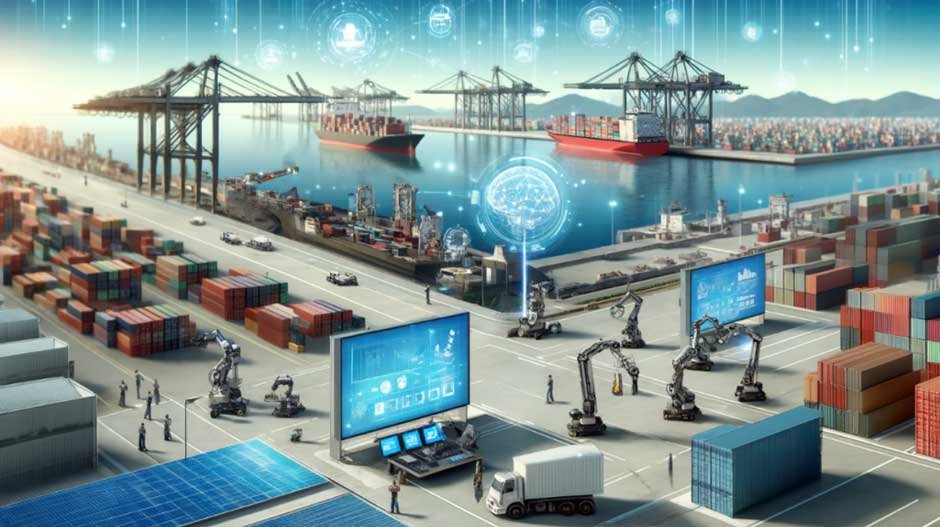The shipping and logistics industry is the lifeblood of the global economy, responsible for more than 80% of worldwide trade by volume. However, as the complexity of global trade evolves, traditional port operations are struggling to keep up with rising demand and expectations. Enter smart ports—a systems-driven innovation designed to optimise trade processes, reduce inefficiencies, and make ports more sustainable.
But what exactly are smart ports? How do they function, and why are they essential for modern global trade? This blog will uncover these answers while exploring the technologies, benefits, and challenges of implementing smart port systems, as well as taking a look at some remarkable case studies across the world.
If you’re a supply chain manager, logistics professional, or trade analyst, keep reading to learn how smart ports are transforming the efficiency of global trade.
What Are Smart Ports and Why Are They Important?
A smart port leverages advanced technologies to optimise port operations, improve efficiency, and drive better decision-making. By integrating digital tools like IoT, AI, and blockchain, these ports enable real-time communication, predictive maintenance, and process automation.
With global trade volumes surging, traditional ports often face bottlenecks that lead to delays and increased costs. Smart ports, however, are designed to manage growing trade volumes efficiently, ensuring quicker turnaround times and enhanced productivity. As supply chains become more interconnected, the importance of smart ports continues to grow.
Key Technologies Driving Smart Ports
Internet of Things (IoT)
IoT is pivotal to the functioning of smart ports. By deploying IoT sensors across port facilities, real-time data can be collected on cargo movement, equipment status, and environmental factors. For instance:
- Cargo Tracking: IoT-enabled tracking devices monitor the location and condition of shipments.
- Equipment Monitoring: Sensors detect potential equipment failures before they occur, ensuring smooth operations.
- Environmental Reporting: IoT devices track weather conditions and emissions, helping ports meet sustainability goals.
Artificial Intelligence (AI)
AI plays a crucial role in optimising logistics and operational workflows. Some applications of AI in smart ports include:
- Predictive Analytics: Forecasting cargo volumes to prevent congestion.
- Resource Allocation: Assigning equipment and labour dynamically based on real-time needs.
- Risk Detection: Identifying security risks using machine learning-powered anomaly detection.
Blockchain
Blockchain technology ensures transparency and security in port operations, particularly in documentation and transactions. Key benefits include:
- Secure Data Sharing: Blockchain enables tamper-proof documentation, simplifying processes like customs clearing.
- Smart Contracts: Automated contracts streamline payment processes between multiple stakeholders.
Automation
From self-driving vehicles to automated cranes, automation is transforming the way ports handle cargo. For example:
- Automated guided vehicles (AGVs) transport containers more efficiently within terminals.
- Robotic arms handle tasks like container handling and cargo sorting, reducing human error.
Benefits of Smart Ports
The integration of these technologies brings significant advantages, including:
1.Enhanced Efficiency
- Faster turnaround times for ships, reducing idle berthing periods.
- Real-time data analytics allows for proactive problem-solving, minimising disruptions.
2.Reduced Costs
- Automation reduces reliance on manual labour, bringing down operational costs.
- Predictive maintenance lowers the frequency of costly repairs.
3.Improved Security
- IoT and AI-based surveillance systems detect suspicious activities and minimise theft.
- Blockchain provides a secure framework for managing sensitive trade data.
Case Studies of Successful Smart Port Implementations
Port of Rotterdam, Netherlands
Often hailed as the most advanced smart port globally, the Port of Rotterdam uses IoT sensors and AI to monitor shipping lanes, streamline operations, and predict wait times. The port’s digital twin—a virtual, real-time replica—simulates scenarios to optimise logistics planning.
Port of Singapore
Singapore’s port has implemented automation extensively, including automated cranes and AGVs. The port also uses blockchain-based systems for transparent international trade documentation, reducing paperwork and delays.
Port of Hamburg, Germany
Hamburg has adopted smart traffic management systems to reduce congestion around the port area. Additionally, it uses predictive analytics to minimise ship waiting times and improve resource allocation.
Challenges and Solutions
Despite their benefits, smart ports face several challenges that stakeholders must address:
1.Data Security
Issue:
The reliance on IoT and connected systems makes smart ports vulnerable to cyberattacks.
Solution:
Implementing robust cybersecurity protocols, including encrypted data transmission and regular system audits, ensures safe operations.
2.Integration of Systems
Issue:
Integrating legacy systems with new technologies can be complex and expensive.
Solution:
Opting for scalable solutions and phased implementation strategies helps achieve smooth integration.
3.Workforce Training
Issue:
Advanced technologies require skilled operators, which traditional port workers might lack.
Solution:
Organising training programmes and partnering with tech providers ensures employees adopt new systems effectively.
The Future of Smart Ports
The future of smart ports looks promising, with emerging trends like:
- 5G Connectivity: Enabling faster and more reliable data transmission.
- AI-Driven Resilience: Enhancing ports’ ability to adapt during crises like pandemics or supply chain disruptions.
- Sustainability Focus: Integrating green energy sources and reducing emissions within port operations.
By 2030, smart ports might become the global standard, significantly contributing to trade efficiency and sustainability.
Transforming Global Trade with Smart Ports
Smart ports are no longer just a concept—they are a necessity in today’s fast-paced trade environment. With cutting-edge technologies, they eliminate inefficiencies, reduce costs, and strengthen security, making global trade more agile and resilient. Supply chain professionals, logistics managers, and trade analysts must prepare to harness the potential of these advanced systems to stay competitive.
Frequently Asked Questions
How do smart ports improve cargo handling efficiency?
Smart ports use IoT sensors, automated systems, and AI-powered algorithms to optimise cargo movement. These technologies enhance precision and minimise downtime.
How do IoT sensors work in smart ports?
IoT sensors collect real-time data on cargo status, equipment performance, and environmental conditions. This information helps in proactive decision-making and efficient port operations.
How does automation in smart ports improve productivity?
Automation eliminates manual errors, accelerates container handling, and reduces the workload on human operators. Automated cranes and vehicles ensure faster and more consistent operations.
